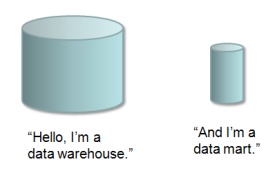集市层
四层模型
ODS(临时存储层)
MID(中间层)
DM(数据集市层)
APP(应用层)
http://www.datamartist.com/data-warehouse-vs-data-mart

【全集 子集】
Data Warehouse:
- Holds multiple subject areas
- Holds very detailed information
- Works to integrate all data sources
- Does not necessarily use a dimensional model but feeds dimensional models.
Data Mart
- Often holds only one subject area- for example, Finance, or Sales
- May hold more summarised data (although many hold full detail)
- Concentrates on integrating information from a given subject area or set of source systems
- Is built focused on a dimensional model using a star schema.

【多层数据策略】
Build a multi-level data strategy
- Level 1- Get the data to the people
- Level 2- Build Departmental Data Marts
- Level 3- Plan long term infrastructure and architecture
Don't do these things in order- this isn't step 1, 2, 3- actively work on all three levels at once and ensure the plans at each level are coordinated.
Operational data store
An ODS is not an intrinsic part of an Enterprise Data Hub solution, although an EDH may be used to subsume some of the processing performed by an ODS and the Enterprise Data Warehouse. An EDH is a broker of data. An ODS is certainly not.
An operational data store (or "ODS") is a database designed to integrate data from multiple sources for additional operations on the data, for reporting, controls and operational decision support. Unlike a production master data store, the data is not passed back to operational systems. It may be passed for further operations and to the data warehouse for reporting.
Because the data originate from multiple sources, the integration often involves cleaning, resolving redundancy and checking against business rules for integrity. An ODS is usually designed to contain low-level or atomic (indivisible) data (such as transactions and prices) with limited history that is captured "real time" or "near real time" as opposed to the much greater volumes of data stored in the data warehouse generally on a less-frequent basis.
The general purpose of an ODS is to integrate data from disparate source systems in a single structure, using data integration technologies like data virtualization, data federation, or extract, transform, and load (ETL). This will allow operational access to the data for operational reporting, master data or reference data management.
An ODS is not a replacement or substitute for a data warehouse or for a data hub but in turn could become a source.